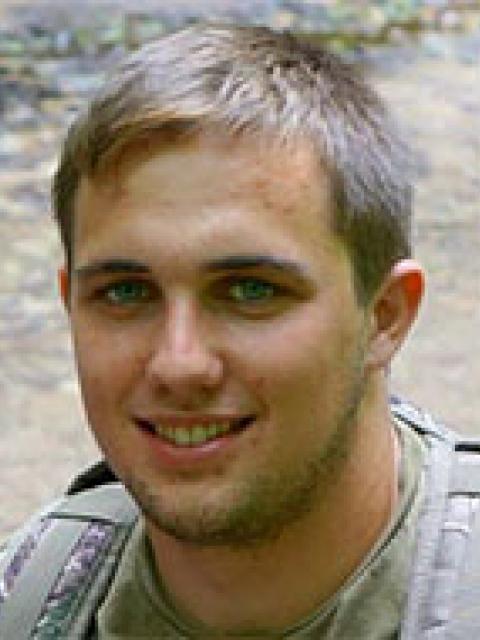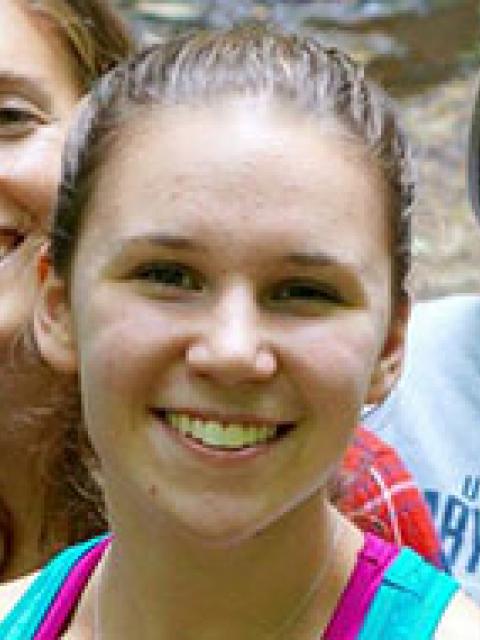
Eniola Afolayan
Sociology and Anthropology at the University of Mary Washington
Faculty Mentor: Tina Lee
Research Project: This Land Was Made for You and Me: On Property Rights Discourse and Lake Clean-Up Efforts
My name is Eniola Afolayan. I am a rising senior in the Department of Sociology and Anthropology at the University of Mary Washington located in Virginia, USA. During the summer of 2014, I conducted ethnographic field research in the Makushi village of Surama, Guyana on the social and symbolic significance of traditional foodways. This research gave way to my interest in subsistence agriculture and environmental anthropology. Through this REU I was able to cultivate my love for both of these subjects. My other current research interests include social justice, indigenous knowledge, development discourses and technologies of power.
This Land was Made for You and Me: On Property Rights Discourse and Lake Clean-Up Efforts
View Research Project Here
When I was deciding the title of my research project, the song "This Land is Your Land" by Woody Guthrie immediately came to mind. I remember singing the feel-good lyrics in elementary school, mindlessly and aimlessly without actually taking the words into account. At first, I misunderstood it as a song in favor of individual right to land; however, it is actually a celebration of everyone's right to enjoy the beautiful land in our country. It is especially fitting for the research I conducted this summer as part of the LAKES REU. Truly, I wonder what elementary-age Eniola would have to say to current day Eniola if she found out that song would someday become part of the thesis of her summer research project.
I've had the pleasure of living in the once unpronounceable Menomonie, Wisconsin for two months this summer. Even after the 8 weeks, riding my bike along Lake Menomin has never once become dull. The same freshness that I experienced in my first week still overcame me as I would ride along to the Agricultural Service Center or perhaps on a journey with my peers to find the Northern Lights during midsummer nights. Lake Menomin has truly been the most enjoyable part of my trip, so doing my research project on efforts to clean it up easily became very meaningful to me.
The purpose of my research project was to understand policy implementation, specifically looking at the Dunn County Shoreland Protection Ordinance. In studying policy implementation, I was trying to understand how policies are received and understood by landowners, including farmers. To collect data, I used participant observation, which meant attending public meetings such as the Dunn County Board’s Planning Resource and Development Committee and Local Work Group meetings. In these meetings, I was able to better gauge how local government works and how government officials make decisions. In addition to that, I job shadowed policy actors, interviewed both homeowners and policy actors, and partook in farmer surveying efforts with our sociology group.
I found that when talking about policy with different landowners and even policy makers, discourses surrounding property rights and land ownership often came up. In some cases such discourses facilitated lake clean-up efforts while others hindered such efforts. When talking about land ownership, three themes stood out to me: the value people attached to their property, anti-regulation views, and conditional support for regulation. I found that in relation to policy, people would often talk about what their property meant to them, such as whether their home had an emotional value and so forth. In the case of anti-regulation, people often talked about how they didn't want government officials telling them what to do on their property.
Finally, people who expressed conditional support supported the Shoreland Protection Ordinance but didn't understand it completely or didn't know how to go about complying.
Because local government officials lack resources, like time and funding, lake clean-up efforts have to be collective and voluntary. One way to make such efforts more collective is by tapping into people's attachment to their property. A dirty lake affects everyone, including those who don't want to be told what to do on their property, because it effects how people value and enjoy their property. I found that many people want to contribute to better water quality but need more information about why regulations are in place and how they can comply. Drawing on people’s desires for beautiful scenery, clean water for swimming and fishing, and yards they can enjoy can help motivate everyone to chip in once they understand their roles. One shouldn't have to live along the lake to value it; Lake Menomin, from my experience, is a hidden treasure in Menomonie, something that all of its citizens should value and take pride in. Pointing fingers will not solve the problem. Coming together as one to persevere this hidden treasure for the future should instead be the goal.One thing I am taking with me forever from this experience is the reassurance that there is truly power in local government. I am glad I got to see that in action in Menomonie, Wisconsin.

Lanna Anderson
Biology at Bennett College
Faculty Mentor: William F. James
Research Project: We Are the Solution: Phosphorous
My name is Lanna Anderson and I'm a senior Biology student at Bennett College. My academic goals after completing my undergraduate degree is to attend graduate school for my PhD. I'm currently unsure as to what my interest of study is but I hope to find my passion as I learn about what I'm passionate about. I enjoyed my summer research experience and I plan to use the lessons I learned throughout my academic endeavors.
We Are the Solution: Phosphorous
View Research Project Here
Phosphorus is one of the key elements necessary for the growth of plants and animals and in lake ecosystems, it tends to be the growth-limiting nutrient. In plants, phosphorus is essential for photosynthesis, respiration, seed production, root growth and other critical functions. Phosphorus in animals is critical for proper bone and muscle growth, metabolism, reproduction, and overall animal performance. Phosphorus (P) largely limits phytoplankton growth in freshwater systems. Excessive P-loading into lakes and reservoirs can lead to cyanobacteria blooms and potential toxicity.
Reservoirs are impoundments of large rivers that drain extensive watersheds, advective flow, flushing rate, and residence time can also regulate phytoplankton dynamics. For instance, during storm runoff and elevated flow, residence time can decrease to less than a week, while flushing rate increases. Even though soluble P loading can be high and available for phytoplankton uptake during these periods, rapid flushing that exceeds the algal growth rate can lead to anomalously low chlorophyll in the reservoir due to washout of the algal community. During lower flow, residence time increases, while flushing rate decreases. Antecedent P-loads assimilated by phytoplankton during these periods can result in bloom development and chlorophyll increases because the phytoplankton doubling time now exceed flushing rate.
My research measured seasonal variations in phosphorus and chlorophyll concentrations and Secchi transparency in relation to hydrodynamics and nutrient (primarily phosphorus) availability in Tainter Lake, Wisconsin. We hypothesized that although P concentrations would increase in Tainter Lake during periods of high flow, chlorophyll would be abnormally low due to the high flushing rate. Conversely, as flow and P loading subsided and residence time increased, high P availability would lead to phytoplankton blooms and chlorophyll increases if algal doubling time exceeded the flushing rate.
Our results showed that during high flow periods, total P and SRP increases in the head waters. This is due to runoff flowing into the lakes from due to a rain storm. Longitudinal gradients decreases total phosphorus and soluble reactive phosphorus concentration toward the dam. SRP is very high and available for algal uptake. During this time, residence time is low, resulting in a washout of the phytoplankton community. Chlorophyll decreases vastly because the flushing rate increases causing a washout of the chlorophyll. During low flow periods, total phosphorus and soluble reactive phosphorus decreases. SRP declines tremendously near the dam in conjunction with massive chlorophyll increases signifying uptake for growth. At this time, residence time is much higher and phytoplankton doubling exceeds the flushing rate. Rapid algae blooms occur because the residence time increases and it causes the lakes to become toxic, green and smelly.
In conclusion, algal growth can be limited by advection and transport in rapidly flushed reservoirs like Tainter Lake even though phosphorus concentrations are high and available for phytoplankton uptake. In an idealistic world we could wish for more rain in order to continue the washout of phosphorus, but that’s not a definite solution. My project was designed to give a scientific insight on what’s occurring in the lakes. I believe that this gives community members a better understanding of not only the environmental issue, but also the steps necessary to take in order to maintain and improve the lakes water quality and beauty. This problem is not pointed at one individual, but a community as a whole has to take responsibility for their own actions so that change can be made.
This REU summer internship has changed the way I look at certain issues. For instance, initially I thought that it could all be solved if farm practices would be conservatory. As I dug deeper into my research, I realized that the issue is much more complex. The community as a whole has to take responsibility of this issue and look for ways in which they could contribute to a solution. It can be as simple as informing your neighbor about the issue and spreading the word. For those who live on the shorelines, one might consider investing in buffer so that runoff into the lakes can be limited. For farmers who have adapted conservative practices, it would be beneficial to inform other farms about the lake issue and how they may be contributing to its continuous problem. With everyone educated about the issue, we can someday come to a solution that is economically and environmentally impactful. This is only the start to a long road to recovery.

Yanira Campos
Sociology at East Carolina University
Faculty Mentor: Nels Paulson
Research Project: Fair Enough: Farmer-Led Councils and Adopting BMPs
My name is Yanira Campos and I am an undergraduate at East Carolina University. I am a B.A. student, majoring in sociology and minoring in psychology. I am passionate about working with minorities and helping create social change. Upon graduating East Carolina I hope to pursue a law degree in immigration. I am southern. I am Hispanic. I drink sweet tea, I say “y’all”, and I play corn hole. However, I say “Bueno” when I answer the phone, I carry around a bottle of hot sauce with me, and I am completely in love with bachata.
Fair Enough: Farmer Led Councils and Adopting BMPs
View Research Project Here
How fair is fair? Is fair being able to only order McNuggets from 11 am to 4 am? Why can’t I have chicken nuggets at 9 in the morning? Maybe it’s because those are the policies and regulations that are in place for distributing food. I could call customer service and ask them why I am limited to these certain hours. However, is calling customer service a fair process for voicing my opinion? Must I revaluate my situation? Are the policies and regulations fair? Similar to this McNugget example is the situation that farmers find themselves in, but they are not just dealing with chicken nuggets.
My research focused on adoption of Best Management Practices (BMPs) within farmer social networks. These BMPs are practices that are proven to help reduce run-off and help improve water quality. Examples of BMPs are putting in grass waterways, using no till, utilizing cover crops, and developing nutrient management plans. For my research I was also interested in perception of fairness among the farming community and how that played a role in adopting Best Management Practices.
Throughout the research process I learned that perceptions of fairness within the farming community was significant and played an important role in predicting whether or not they adopt BMPs. The fairness variable included if polices, regulations, and whether the process of voicing opinions was fair or not. These three questions were scaled into one variable for a combined effect on prediction of adopting BMPs.
If farmer doesn’t believe in the practices and the regulations that are in place for certain practices, then they lack the passion for the work that they are doing to change their practices. Farmers need policies and regulations that they believe in and they can fully trust. There is nothing motivational about doing something that you don’t believe in. Farmers are passionate about their fields and crops and they exemplify it through the amount of time that they spend on taking care of those fields and crops. As I talked to farmers during this summer, I could see how passionate these farmers are about their work.
Equally important with fairness, other great predictors of BMPs are education, gross farm sales, and willingness to work with farmer led councils.
As the research continued and I learned that farmer led councils were a great predictor of BMP adoption. I wanted to find out what was a predictor of person willing to work with farmer led councils. Farmer led councils are a way to get farmers connected with each other and a great avenue for the flow and exchange of information. It is also a great way for them to voice their opinion on current policies and regulations.
These small interactions could inevitably spark change for policies in which farmers believe are fairer, again an important predictor of BMP adoption.
Now, think about a person who you would call up at 3 am to go get ice cream with you. Think about if other people would call that same person. This person would probably have high “PageRank”. PageRank is essentially the popularity of a person. My research showed that PageRank was a great predictor of willingness to work with farmer led councils. Other predictors are farm size, and value of land for future generation use.
PageRank was especially important for smaller farms in terms of acreage. Willingness to participate in farmer led councils increased as PageRank for smaller farms increased. However, willingness to work with farmer led councils and PageRank decreased together when measuring larger farms. Smaller farms would be the ones to target in order to participate in farmer led councils.
Lastly, great social change comes about through the collaboration of the government and the people. Social change stems from allowing the people to voice their opinions and correct the aspects in society that are not living up the standards of justices. I hope that that my research has given insight on what can create great social change for the farming community and a change in the environment that can be enjoyed by everyone.

Melanie Ford
Anthropology at the University of California
Faculty Mentor: Tina Lee
Research Project: Business and Tourism Impacts of Lakes Menomin and Tainter
Melanie Ford is a California native studying anthropology at the University of California, Riverside. She discovered her passion for anthropology and the environment by participating in environmental campaigns and discussions on campus concerned with environmental justice. With a concentration in environmental and science and technology studies, she will graduate in 2016 with hopes of attending graduate school to continue to study anthropology and emerging agricultural technologies. When she is not studying, you can catch her swimming in the southern California ocean or sitting in Los Angeles traffic.
Business and Tourism Impacts of Lakes Menomin and Tainter
View Research Project Here
I remember how Lake Menomin complimented Menomonie as we first drove pass it on our way to the dorms. Being in the center of the town, I had originally thought the lake would be filled with swimmers, boaters, and more. But to my surprise, the lake was hardly being used. I understood the lake had algal blooms, but for the first five weeks the water was deep blue, clear, and seemed just as usable as any other lake. During our first week, our professors mentioned how popular the lake was in the winter and how it is filled with lots of activities, people, food, beer and fun. Where was this in the summer?
After hearing oral histories regarding how the lake used to be central to summer activities in Menomonie in the ’60s, ’70s and even ’80s, I became interested in understanding how the polluted lake impacted business and tourism in Menomonie. Residents often spoke about how they used to swim at Wakanda Beach when they were younger with their friends and families, and how much of a community center the lake used to be with more visitors and lake-centered businesses. I was curious to see how and why this declined and what the future potential a clean lake could hold for local business, tourism, and the Menomonie community. I interviewed several business owners and others who were associated with the tourism industry in the city and in Dunn County to better understand how pollution affects Menomonie in the summer.
One finding was that some in the business community expressed that algal blooms during the summer months negatively impact business. In addition, some in the business community also expressed frustration about the progress of lake clean-up efforts and perceived policy actors as being unsupportive. These two findings are not surprising, but they helped to support my third and most significant finding: that most of those I interviewed did not discuss the lake at all when discussing positive attributes of Menomonie. Many would talk about all the other wonderful things Menomonie has to offer, such as the red cedar bike trails, the historic Mabel-Tainter, and more, but the lake never made their list—not even as a potential selling point.
While many may agree that Lake Menomin is not a tourist attraction during the summer, the most surprising part about these interviews was that people expressed fatalism towards the progress of the lake’s water quality and its future integration into a vibrant community space. Other lake-centered communities were even brought up as examples of why Menomonie would never become a vibrant tourist destination: because there was too much competition with other lake-centered cities, Lake Menomin was perceived as being too small, and the land surrounding the lake was not developed to enhance the view of lake or its qualities. More specifically, those in the tourism industry expressed other focuses that Menomonie could work towards instead, such as agri-tourism and its growing biking community. As I took a step back and looked at my research data, it was clear that the business community is largely working around the lake rather than working with it.

Austin Gentel
Environmental Science at Delaware Valley University
Faculty Mentor: Matt Kuchta
Research Project: Phosphorous and its Missing Slice of Pie
My name is Austin Gentel and I’m a junior studying Environmental Science at Delaware Valley University, which is located in Doylestown, PA not Delaware. I was born in Frederick, MD which is a great spot to be because I have the life of the city and the environment all around us (there is a reason why we call Maryland a Little America). At school I am involved in everything from VP of my Fraternity (Rho Epsilon Kappa) and the Class of 2017 to working on the Snow Removal Crew in the winter. When I am not at school or working you can find me camping, hiking, working out, or Geocaching, but at the very least I will be showing off State Pride because us Marylanders LOVE to put our Flag on Everything!!
Phosphorous and its Missing Slice of Pie
View Research Project Here
The distribution of phosphorous pollution has been usually represented in a pie chart where it has had no place for the natural occurring phosphorous, hence the reason phosphorous is missing a slice of pie.
It turns out that the water in the creeks are mostly made up of pre-event water, otherwise known as the water that comes from the ground, and soil. This is unlike the new water that enters the stream during a storm because of runoff and direct precipitation onto the body of water. So who cares? Why does it even matter if the creek has water from the ground or if it is from the rain? Well it turns out that this information is very important in the manner that it brings us a new piece of pie that has come from a pie that we believed was already whole.
After working for the entire summer on trying to understand the East and Western parts of the watershed, we came across the results that the water in the streams was from the ground and not just runoff. This is an exciting brand new topic to look at because the ground beneath our feet has an entire story of its own. This story remarkably shows us that the world beneath our feet is not the same when comparing the Western and Eastern parts of the watershed. The East turns out to have layers of rock near the surface that contains natural phosphorus. Alright- that’s something pretty cool, but if it is the rocks then it is stuck there right? Well, sadly that is wrong.
As it turns out while the water travels through the ground it likes to pick up some extra items before it reaches the creeks. One of these items is called silica, which is an element found in rocks and just so happens to be able to be removed by water. Silica was one of the items that we used to figure out that most of the water is from the ground and not the sky. This is a huge point because it turns out water likes picking up phosphorous, just like it does silica. This means in the east the water is bringing in naturally occurring phosphorous into the creeks, such as 18 Mile Creek.
So why should we care about fixing the creeks and changing our practices if the creek is only going to bring in its own phosphorous? Well the simple answer is that we can still focus on the other problems such as runoff and point source pollutions. This discovery leads us to also be able to manage our policies better, so that they take into the account that natural occurring phosphorous is in some of our streams. Now we don’t know actually how much of the phosphorous is natural but it is a lot better to know that our pie is whole once again. In the end this project has and will need the incorporation of all types of people to continue to work towards a solution.
That being said, the LAKES-REU program has allowed us to hit the ground running for a solution, but has also given me and my fellow interns an opportunity to work on a real world solution so that we can actually make a difference in this world, and so that we can be prepared for what lies ahead of us in our lives.
I would like to personally thank all of my fellow LAKES-REU interns and mentors for giving me a one of kind summer that I will never forget. In particularly I would like to thank Dr. Matt Kuchta for teaching me all of the ropes of geological and phosphorous research, and Andi and Jonah for keeping tough and helping me power through the hundreds of water samples that we had to go through this summer. In the end the biggest thank you has to go to the people of Menomonie, Wisconsin and of the Red Cedar Watershed for being so accepting of us, for teaching us and making us feel like one of your own. I’m so glad that I was able to give back to you and hopefully help make a better difference in your life. So again, thank you to everyone for giving me this amazing summer! I have a long drive back to Frederick, Maryland but I will miss you all and surely someday I will be back here in Menomonie and see you all again.

Joshua Herron
Applied Social Science at the University of Wisconsin-Stout
Faculty Mentor: Nels Paulson
Research Projects: Best Management Practices: Farmers and their Social Networks
My name is Joshua Herron. I am going into my senior year at the University of Wisconsin-Stout in the Applied Social Science major, concentrating in History and Politics. History and Politics courses have led me to my true passion, Peace Studies. I often find myself reading incredibly depressing documents about all of the horrible things that are happening to wonderful people throughout the world and trying to come up with effective changes. When I’m not doing that you can find me going on hikes, playing video games, listening or creating music, or just helping local and student led organizations. The LAKES REU program has given me an opportunity to take my research skills and apply them to a visible problem in the local community that effects the global ecosystem. I asked farmers about their use of Best Management Practices and how we could effectively help them to implement these practices to limit the amount of phosphorous and sediment that enters and destroys the waterways. My ultimate goal with my research is always to find a way to get all parts of society interested in making the changes needed. This research experience allowed me to look into the local waterway problems and find solutions with everyone that lead to desirable results.
Best Management Practices: Farmers and their Social Networks
View Research Projects Here
Best Management Practices are farming practices that help increase soil health, decrease soil erosion, and stop excessive amounts of agricultural runoff. This means less phosphorous and solids enter the streams, rivers, and lakes, thus lowering the amounts of blue green algae blooms that are causing the toxicity, cloudiness, and smell of the lake. There are many predictors that have a significant input on increasing or decreasing BMP implementation but, for the sake of this summer’s project, I looked into farmers’ social networks. My research suggests that to increase BMP use farmers need to become part of a social network, most effectively through Farmer-Led Councils, which would help deal with other problems that hinder the adoption of BMPs.
The LAKES REU program was a great experience because in an 8 week program I learned so much about survey creation, data input, and statistics. The farmer survey that we created consisted of about 15 minutes worth of questions that ranged from personal values to fairness to education on farming practices and implementation of best management practices. There were also questions about willingness to work with local and state agencies to implement BMPs. All of the questions were shaped to get a feel about what stands in the way and what is helpful for the adoption of BMPs.
The results for my project were two different regression models with an interaction and a social network graph. The first regression model was created with BMP usage as a dependent variable, meaning the variable that is dependent upon the influence of other variables, called the independent variables. The independent variables for the model were soil test frequency, closeness centrality, ecological impact, perception that farmers are unfairly targeted as problems of water quality, the value of organic matter, and farm size. All of these variables came together as valuable predictors for the BMP use, with soil test frequency, closeness centrality, unfairly targeting farmers, and value of organic matter all being statistically significant. This brings in the second regression model and where it gets really interesting.
In the second regression model we used closeness centrality as the dependent variable (since this is a good predictor of BMP usage, we wanted to know what predicts high closeness centrality). Essentially, closeness centrality measures if somebody is highly connected to a network yet not directly connected to many people (e.g. so they may trust farming advice from only two other people in the network, but through those two people they are connected to a dozen others who may relay knowledge to them).
We found that age, social connection information (like Farmer Led Councils), capital costs, farm size, and an interaction between farm size and capital costs were predictors of whether or not a farmer has high closeness centrality (thus leading to higher BMP use).
The really interesting part of these results was the interaction. This interaction showed that while all farmers worry about capital costs, for farmers of fewer acres capital costs have much more of an impact on their closeness centrality than larger acre farm producers. This suggests smaller acre farmers need financial help if they are going to get integrated into the network of farmers in the watershed and if they are going to adopt BMPs.
What does this mean? Farmers need help with the finances behind implementing BMPs, but it is not just about money. Farmers also need to be brought into the networks, because word alone within a network has impact on the farmers BMP index. More Farmer Led Councils working with UW-Extension, NRCS, and Land Conservation Divisions could tackle both of these problems up to a point by getting more farmers into larger social networks and creating more suitable incentive programs to help ease the capital costs of BMP implementation. Ultimately, relatively easy changes can be made if farmers work together to create the infrastructure necessary to implement BMPs and remove phosphorous from our waterways.

Megan Isaacs
Financial Economics at the University of Redlands, CA
Faculty Mentor: Chris Ferguson
Research Projects: Two Lakes Worth Cleaning? How cleaner Lakes Menomin and Tainter would benefit the community
My name is Megan Isaacs and I am entering my senior year at University of Redlands, CA. I’m majoring in Financial Economics and look forward to graduating in April 2016. I have a strong interest in economics and the theories behind decision making since it can help society in so many different ways: how to allocate resources, reduce unemployment, and increase overall efficiency. When I’m not at school I enjoy working as a nanny, reading, or going on hikes and exploring the world around me.
Two Lakes Worth Cleaning? How cleaner Lakes Menomin and Tainter would benefit the community
View Research Project Here
For a town built around a lake, I was surprised at the lack of people on the water when I saw Lake Menomin for the first time. Two boats, one person fishing, and no one swimming. It wasn’t until I heard more about the toxicity, smell, and blue-green algae that I got a sense of how people view it in the summer.
In one of the first conversations I had, I learned that the lake turns green and gives off a bad stench. Little did I know that that would be the theme of several more conversations, among many different groups of people. The green water and smell drive many people away from what should be a beautiful asset to the city if there were cleaner, clearer lakes.
Several of the business owners I spoke with expressed that the smell gets so bad they keep their windows and doors shut, and people don’t go downtown as frequently.
It’s apparent the lake is influential on the community. My research focused on the impact that cleaner Lakes Menomin and Tainter would have on the local economy.
I surveyed Menomonie citizens, businesses, UW-Stout staff, and students to gain a better understanding of how these groups would be impacted if Lakes Menomin and Tainter were cleaner and usable during the summer.
Results showed that the lakes are currently being used below their potential. If the lakes were cleaner, 50% of those surveyed said they would fish more, 60% would boat more, and 72% said they would swim more. Approximately 40% said they would visit downtown more frequently.
It is clear that lake recreation would flourish and, with more visitors downtown, local businesses would expect to grow.
One question I asked students was whether or not they would stay in Menomonie during the summer if the lakes were usable. Currently, about 26% of survey respondents already stay. An additional 33% of students said they would be much more likely or definitely would stay. This would translate to an additional 2,700 students and a much more vibrant summer economy.
I then asked businesses questions about what a typical summer month looks like for them, including revenue, employment, and their clientele, followed by a question asking them to forecast what changes in employment and revenue they would expect if about 2,700 more students were to stay. Retail, restaurants and accommodations, and services projected the most growth, with an average of 25% growth in summer revenue and 46% growth in summer jobs in these sectors.
This is about $36.6 million in additional revenue and 1,500 jobs.
These are conservative predictions since other industries would also experience a positive response. The small local businesses most directly effected in these retail and service sectors tend to retain most of these additional revenue dollars within the local economy. As the additional revenue continues to cycle through these sectors, as well as other areas such as real estate and financial services, the local multiplier effect could be expected to double or triple the impact of those dollars in the Menomonie and Dunn County economies and benefit more and more businesses – even those not directly impacted by tourism or student clientele.
The benefits are simple yet important: people would increase their lake use, a large portion of students would stay, and businesses would experience meaningful growth.
The problem will only be reversed when policy makers and community members are able to decide on the best course of action. However, from the conversations I had and the results I received, there is such a strong sense from the community for a desire for change. I hope my research contributes to keeping the conversations about water quality going.

Nicole Loeven
Biochemistry and Molecular Biology at Wells College
Faculty Mentor: Stephen Nold
Research Project: We Have What it Lakes to Make a Difference
My name is Nicole Loeven. I am a senior at Wells College studying Biochemistry and Molecular Biology. I am interested in pursuing at least a master’s degree in Pharmacology after I complete my bachelor’s degree. My experience at the UW-Stout LAKES REU was really positive and I learned a lot. Doing research and applying the knowledge that I received in school was new and exciting. This opportunity also gave me confidence. I am now eager to start applying to graduate school programs and know more about myself. Aside from work and school I also play collegiate volleyball and enjoy hiking and spending time outdoors.
We Have What it Lakes to Make a Difference
View Research Project Here
Cyanobacterial blooms of blue-green algae plague the lakes near Menomonie each summer. I was awarded the opportunity to come to Wisconsin to participate in research to combat this problem as part of the LAKES REU program.
My research project primarily looked at the impact of the Red Cedar and Hay Rivers on Tainter Lake and the development of cyanobacterial blooms. I found that as river flow increases there is also an increase in total phosphorus to the lake as well as soluble reactive phosphorus, the type that is most readily available for cyanobacteria to use to grow. While all phosphorus causes blooms, soluble reactive phosphorus should be a target for remediation strategies.
So how does soluble reactive phosphorus increase with river flow? To understand the answer you have to look at what is going on physically within the river when a major precipitation event occurs. Most of the time the rivers are in a low flow state, and little phosphorus enters the system. When a storm hits hard and water begins to run off the surface of the surrounding land, the river’s volume increases greatly. Impenetrable surfaces such as tilled farm fields and paved areas are particularly susceptible to surface runoff. This is how major storms that occur throughout the summer months can cause enormous amounts of phosphorus to enter the lake.
Storms make the water travel quickly and even violently, including the water at the bottom of the river. As the river volume increases the streambed churns causing phosphorus to re-suspend and dissolve into the water. This increase in soluble reactive phosphorus increases the algae “food” and prepares the next round of algae to multiply. Later in summer months this build-up of phosphorus and algae becomes too great to manage by occasional rain and the smelly, green lake is there to stay until cooler weather comes.
So how do we best approach this problem? My findings suggest that the best way to reduce soluble phosphorus in the rivers and lakes is to better manage land in the Red Cedar Watershed. Best management practices for farmlands, as well as dam and lake management, will be key areas to explore for ways to reduce phosphorus from the watershed’s system of streams, rivers and lakes.
The goal to ultimately reduce, delay, or eliminate the algal bloom is widely desired, but all people will have to work together to meet this goal. By gaining a better understanding of the problem, mitigation strategies can be tailored to best meet the needs of the Red Cedar Watershed and Tainter and Menomin Lakes.

Lisette Solis
Political Economy at the University of California Berkeley
Faculty Mentor: Chris Ferguson
Research Project: Be a Good Neighbor, Put in a Buffer Strip:
Why putting in a buffer strip is worth your time even if no one is checking
Lisette Solis studies Political Economy at the University of California Berkeley. She has a particular interest in issues of sustainability and development which she hopes to study further after graduating this spring. Especially after her experiences this summer, she is very interested in public policy and hopes to pursue a career in this area. While not in school you may find her lifeguarding or swimming at the pool, or hiking in the Berkeley hills, or lounging in the park. She believes it is her love of being outdoors that fuels her passion for environmentalism.
Be a Good Neighbor, Put in a Buffer Strip:
Why putting in a buffer strip is worth your time even if no one is checking
View Research Project Here
For the past two months I researched shoreline regulations which require homeowners and farm owners to put in buffer strips along the lakes and rivers. These buffer strips act as barriers which can help trap sediment and phosphorous runoff before it reaches the water. While regulations at the state and, until recently, the county level have been in place for years, they have not been strictly enforced and only an estimated 35% of the homes on Tainter Lake are in compliance.
The key thing I investigated this summer is what motivates these people to cooperate with shoreline regulations. I found that people who know about the ordinances are more likely to have a buffer strip, but those who express concern about water quality are exponentially more likely to have a buffer strip. To address this officials could more actively enforce the law, which would undoubtedly make the regulations a more important factor in people’s decisions to put in a buffer strip, but my research suggests that this may not be the most efficient use of limited resources. Rather, I suggest that more resources be created to help people understand the impact that buffer strips can have on water quality and to help homeowners understand what the ordinance requires of them.
My estimates suggest that if all of the shore land in the Dunn County portion of the Red Cedar watershed were either natural woodlands or wetlands or had a 35 foot buffer strip as required by the law then 868 pounds of phosphorous (which produces roughly 433,940 pounds of algae!) would be caught before reaching the water each year. Admittedly this is nowhere near enough phosphorous to solve the algae problem, but it is still very significant.
I do not think that the amount of phosphorous that can be diverted by buffer strips makes the cost and effort of enforcing this legislation worth doing so; however, I do think it is enough to warrant the attention of shoreline home owners. In my opinion, the real strength of this ordinance is that it involves individuals in the solution.
On the surveys we distributed we asked citizens and property owners: Whose responsibility is it to clean-up the lake? As so many people pointed out, it is everyone’s responsibility. It is easy to point at someone else and say that it is their job to find a solution, but if you want the lake to be clean, then it is your responsibility as well. There is certainly a role for the government in solving this problem and for farm owners, but there is also a role for community members. Shoreline regulations like this are important and somewhat unique in that they apply to both townspeople and farmers. Complying with these regulations is, in my opinion, the easiest and best way for shoreline home owners to acknowledge their role in the problem and their commitment to finding a solution, without which it is unreasonable to expect cooperation from others.

Andi Twiss
Environmental Studies at Gustavus Adolphus College
Faculty Mentor: Matt Kuchta
Research Project: A Summer's Worth of Research, and More Work to Do
My name is Andi Twiss, I go to school at Gustavus Adolphus College in Saint Peter, MN. I am pursuing a B.A. in environmental studies with minors in political science and peace studies. In December 2015 I graduate and hope to pursue work through the University of Minnesota or other employers within the Twin Cities area that are environmentally focused. This focus can be on policy management, research, continued education, enforcement, dissemination, or curriculum development. Whatever employment I pursue, I hope to bring an interdisciplinary perspective to my position thanks to my experience at UW-Stout. Beyond the work I did at Stout and the relevant studies I partake in at GAC, my interests include spending time with loved ones, enjoying the outdoors, and reading.
A Summer's Worth of Research, and More Work to Do
View Research Project Here
Phosphorus (P) is a labile naturally occurring element. It is one of a few essential elements required for the health and growth of many plants and animals; both terrestrial and aquatic. P comes in many forms, and is generally measured in the form of Total Phosphorus (TP) which includes all forms that P in in a given space. TP is broken down into multiple forms including Soluble Reactive Phosphorus (SRP), Particulate Phosphorus (PP), Inorganic Phosphorus, and Organic Phosphorus. The Environmental Protection Agency and other agencies typically measure P concentration of a space through TP in pounds of loading or in concentration of milligrams per liter.
The concentration of P will shift naturally based on a variety of factors. This can include precipitation patterns, agricultural land use practices, and the exposed bedrock of an area. One of the most influential factors is the agricultural land use. Many farms utilize fertilizer to grow healthy and profitable crops. This fertilizer provides extra nutrients to stimulate plant growth including P. Terrestrial plants on average need higher concentrations of P than aquatic plants. This is important in considering another important factor: precipitation patterns. The rainfall patterns over an agricultural area will result in run off to local tributaries within the watershed, and the run off from fertilizer will wind up in those streams and creeks carrying high concentrations of P. Ultimately, within the Red Cedar Watershed, these P concentrations will wind up in the impoundment of Lake Menomin.
The EPA recommends a concentration of P to be 0.1 mg/L in a healthy stream. Of the two streams studied this summer, Tiffany Creek on the west side of the watershed hovers at around this concentration for most of the summer months with occasional spikes with increases in Total Suspended Solids (water’s cloudiness) after a rain event. 18 Mile creek on the east side of the watershed is more than double this recommendation. However, the EPA recommends streams and tributaries that flow to an impoundment to be half of this concentration at 0.05 mg/L which neither creek come close to. These are just two of many tributaries to the Red Cedar River. To get a full picture of where these creeks measure in concentration of P, additional studies should be done. They will be helpful in determining geographically where the largest concentrations of P are coming from and by determining the source, may lead to finding the most effective way to mitigate it.
The 2013 predictive P sources and their proportions mentioned the following categories: cropland, forest, barnyards, grassland, point sources, and urban. This left no potential source of the naturally occurring P of the bedrock that the streams are running over and constantly interacting with.
This is a source of P that will always be present and cannot realistically be prevented or reduced.
As a result, the man-made contributions of P concentrations need to be reduced even further to make up for what can’t be reduced by the natural sources. These reductions are made through best management practices and continued policy work that reflects the research being done in the area. A Total Maximum Daily Load of P needs to reflect and be proportionate to the catchment size of sub-watersheds, the bedrock of the area, the topography and precipitation patterns, and the land use of the surrounding area. These factors and the research surrounding them need to be consciously considered in determining a TMDL that is realistic and achievable for the area. Having a one-size-fits-all TMDL will result in sporadic changes in different parts of the watershed as reductions in some areas will be very effective where in other areas, the equilibrium concentration of P will prevent the reductions from being very effective. Thus, the TMDL and subsequent reductions need to be reflective of the area it’s trying to assist. Additional studies done by my colleagues determining P concentrations of rain water and base flow and EPC (Equilibrium P Concentrations) of these waters when they interact with various bedrock will need to be continued in order to help propel policy work forward.




